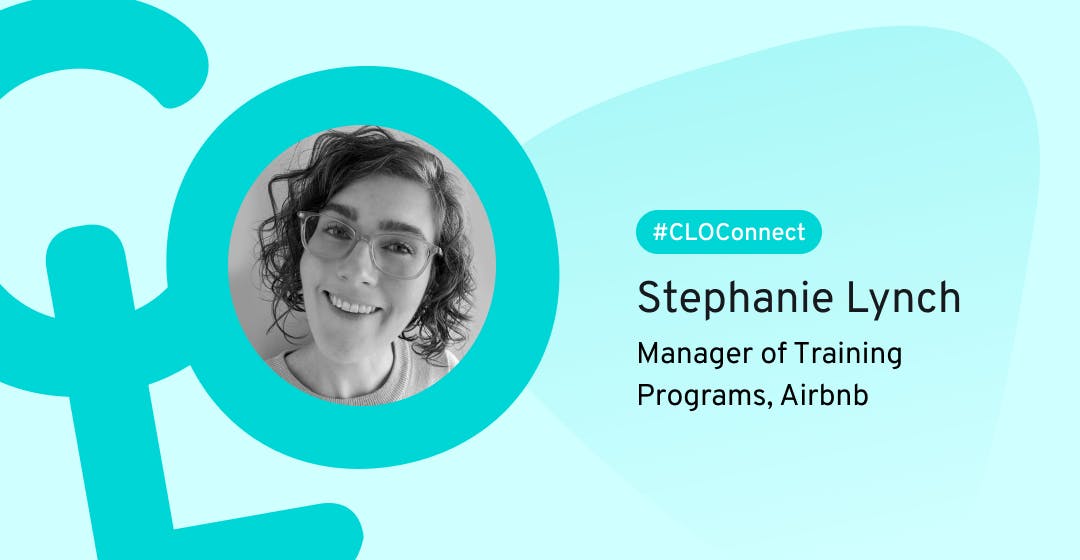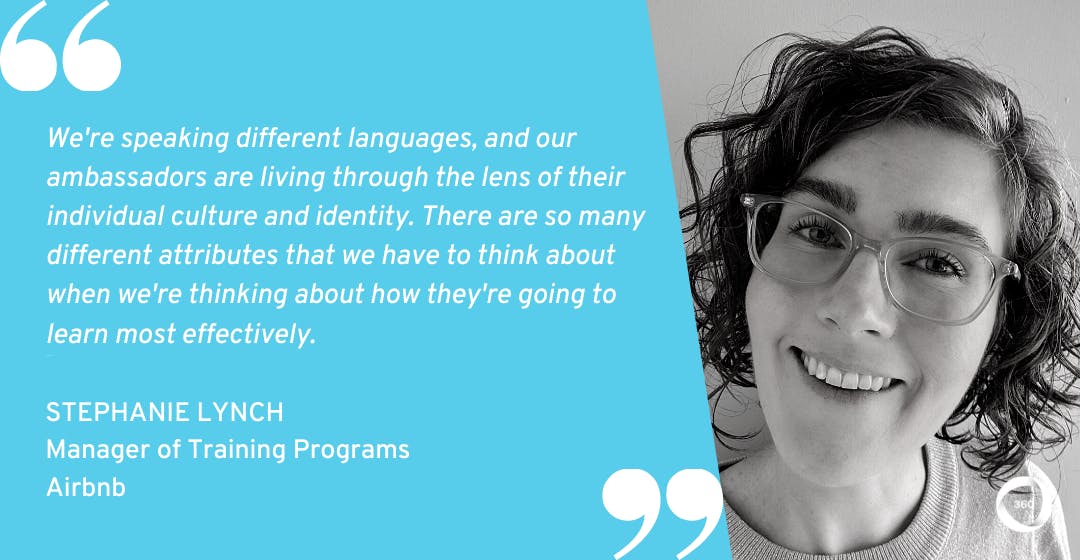
The Power of Shared Experience: How Airbnb Celebrates Diversity through Multicultural Training
Today, more L&D leaders are recognizing the crucial role learning plays in celebrating the diverse and inclusive cultures within their organizations.
But how can you design or adapt multicultural training in a way that matches a broad range of expectations? And how can you implement the many different modalities of language and culture to keep people learning from each other?
To find answers to these critical questions, I spoke to Stephanie Lynch, Manager of Training Programs at Airbnb, about her process for optimizing multicultural training in a global organization, and how her team is measuring the impact of learning through shared experience.
Love to hear more? Read on to hear why multicultural learning is so crucial for a global company like Airbnb.
Loving what you’re reading? Come and join the L&D Collective for more great learning insights, resources, and events!
Why multicultural training is so critical for Airbnb
As Stephanie explains, the learning team at vacation rental platform Airbnb focuses a lot on the functional training of their primary learners. These are their frontline customer service ambassadors who are interfacing with the Airbnb community, taking phone calls and messages, and solving problems.
“So, we're really structured around thinking about: who are our learners?” says Stephanie. “Where are they? What issues are they solving? And then we try to build the learning experiences that they need to help them through their journey.”
The support team is distributed across 20 sites helping Airbnb hosts and guests in over 200 countries. For Stephanie, the big challenge facing the L&D team is designing multicultural training and making sure it is something that everyone can receive and experience.
“We're speaking different languages,” explains Stephanie, “and our ambassadors are living through the lens of their individual culture and identity. There are so many different attributes that we have to think about when we're thinking about how they're going to learn most effectively.”

Stephanie and her team aim to create a consistently high level of support across the countries where their customer support ambassadors are operating. To do so, they have to be able to understand that operating nuance to drive consistency in a way that makes sense on a local and individual level.
“And there are other layers to it,” she adds, “In recent years, some people are learning in the office and some people are learning in a remote setting, and so that certainly adds another layer of complication to the equation.”
So, how do Stephanie and her team make multicultural learning look so easy?
Looking for more expert tips? Find out how L&D leaders at Harry’s, Robert Half, Disneyland Paris and more are turning L&D into a driver of company culture.

What's company culture without L&D?
By providing your contact info, you agree to receive communications from 360Learning. You can opt-out at any time. For details, refer to our Privacy Policy.
Airbnb’s strategy for celebrating diversity through multicultural training
Stephanie and her team have made great headway in optimizing Airbnb’s multicultural training by applying the mindset of being learners themselves.
“We've certainly still got challenges to work through,” she says, “but what we’ve tried to do is take an approach recognizing that we are learners first ourselves. We're trying to continuously learn and continuously improve our curriculum based on what we're hearing.”
So, how does this ‘learner first’ approach work in practice?
1. Think from the learner’s perspective
Stephanie starts by thinking from the customer service ambassador’s perspective.
“We want to try to find where we can help them bridge the gap between ‘this is my personal experience’ and ‘here's what I understand of this experience that the person on the other end of the line is having’,” she explains. “So we're trying to think through how they connect with each other, and how to make sure they can understand each other.”
2. Break down learning into small parts
Next, the team works on creating learning content that is focused and impactful.
“One part of this process that has been critical is breaking down our learning into the smallest parts possible. I think this is critical because the smaller and more discreet we can focus our training, the more we can start to identify things like what's common amongst all of our teams,” Stephanie says.
With this in place, Stephanie and the team focus on creating shared learning experiences.
3. Create shared learning experiences
“I think creating shared learning experiences where we can is so impactful,” Stephanie explains. “People learning together, having different backgrounds and experiences, already gives them some empathy for people that they haven't even met yet, because they're getting to learn with each other.”
Stephanie finds this works especially well when they have facilitated discussion group activities. In a collaborative learning environment, they can try to connect with each other to create a shared understanding.
“I think that breaking things down into small parts is really important so we can start to say, okay, these are the things that everybody needs to know or these are the skills that everybody needs to build.”
“We can put those together and have these touchpoints where everybody gets to learn together and appreciate each other's cultural, learning, and language differences. I think that's a great step forward.”
People learning together, having different backgrounds and experiences, already gives them some empathy for people that they haven't even met yet, because they're getting to learn with each other.
4. Develop localized content
Next, for other topics and skills that aren’t well suited for learning together, Stephanie and her team develop more localized content.
“Part of our strategy has also been thinking about moving past just translations and really thinking about localization beyond language. We have to start thinking about what skills or activities benefit from that localization when we're talking about communication and interpersonal skills.”
5. Collaborate, collaborate, collaborate
For Stephanie and the team, a critical part of creating impactful localization is the informal peer-to-peer learning that happens within the global team.
“We collaborate so much,” she says. “The global curriculum managers that I work with most closely are constantly working with language and local experts in the regions that we work with. We have a robust feedback loop built into any content development processes that we're doing.”
“Before we launch, we typically have one or two rounds of feedback, where we're hearing from folks on how we need to tweak certain things, or which examples we can use that might land a little bit better.”
Airbnb’s strategy for optimizing multicultural training highlights the advantages of collaborative learning. By connecting learners with different experiences and backgrounds and facilitating group engagements, they have created shared learning experiences where everyone learns together.
So, that’s Stephanie’s process for optimizing multicultural learning at Airbnb. But how does the L&D team know they are having an impact?
The global curriculum managers that I work with most closely are constantly working with language and local experts in the regions that we work with. We have a robust feedback loop built into any content development processes that we're doing.
How Airbnb measures the impact of multicultural learning
As Stephanie explains, at a high level they use the Kirkpatrick model as a guide to try to make sure they are looking at the impact they’re having in a holistic way.
“Measuring impact is something that we're always trying to do more and do better,” she says. “We listen to our learners and try to understand directly from them what's relevant and what's not, what's engaging and what's not, and we have seen some positive movement.”
In recent years, Stephanie and her team moved to a more interactive, self-paced e-learning set of options from which they have seen positive learner sentiment. They also implemented mandatory subtitles on all of their courses which has made learning more accessible and has resulted in higher completion rates.
“We also have assessments that we are creating as part of our curriculum,” she explains. “We have our instructor evaluations that help inform how the learners are doing which has really helped us identify tricky areas that people are struggling with and helped us improve the curriculum.”
“But I'd love to be able to create more of that culture of learning,” she says, “where it's just expected that maybe once a month we're doing some kind of skills enhancement type training.”
At the highest level, Stephanie and the team also want to monitor business performance trends and community metrics. “We want to always look at quality and efficiency to balance each other out. Yes, we want to solve issues quickly, but we want to make sure we're solving them really well.”
As Stephanie explains, they take Airbnb’s core value of championing their mission very seriously. “When we know there's a problem, we really want to attack it from every angle. Sometimes that creates a little bit of challenge in knowing which initiative had the impact we're looking for.”
“A few things that we're working to try to improve that is driving greater cross-functional visibility so everyone knows what's going on,” she says, “and having more centralized planning to make sure everyone knows what everyone else is doing and how their work might be impacting or supporting everyone else’s work.”
Related: 3 Data-Based Ways To Prove Training ROI (+ Free Training ROI Calculator)
Thanks to Stephanie for sharing her exciting journey and experience with us!
For more practical tips on recognizing organizational diversity through learning, check out our interview with Tuba Kazmi of Coca-Cola on celebrating a diverse workforce, and with Jodi Leffingwell of the SmileDirectClub on supporting gender equality in the workplace.
Want more peer insights on transforming workplace learning? Sign up to become a member of the L&D Collective, and check out our other #CLOConnect interviews with top L&D leaders on driving growth and scaling culture through Collaborative Learning. Or you can subscribe (below 👇) to our weekly newsletter to receive our latest posts directly in your inbox.

